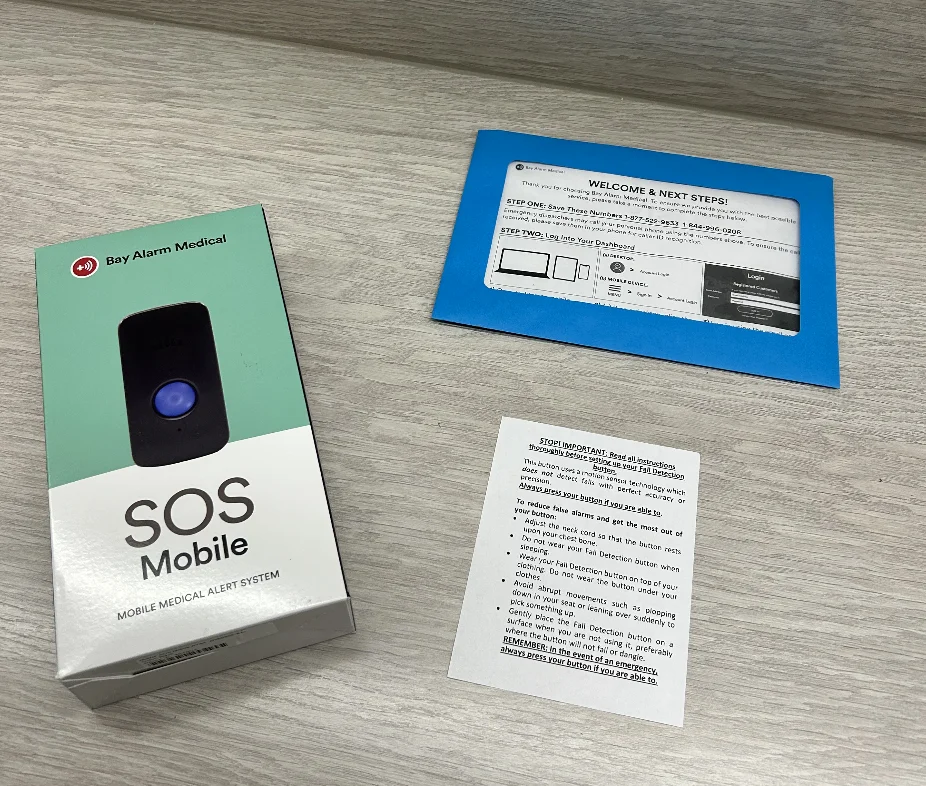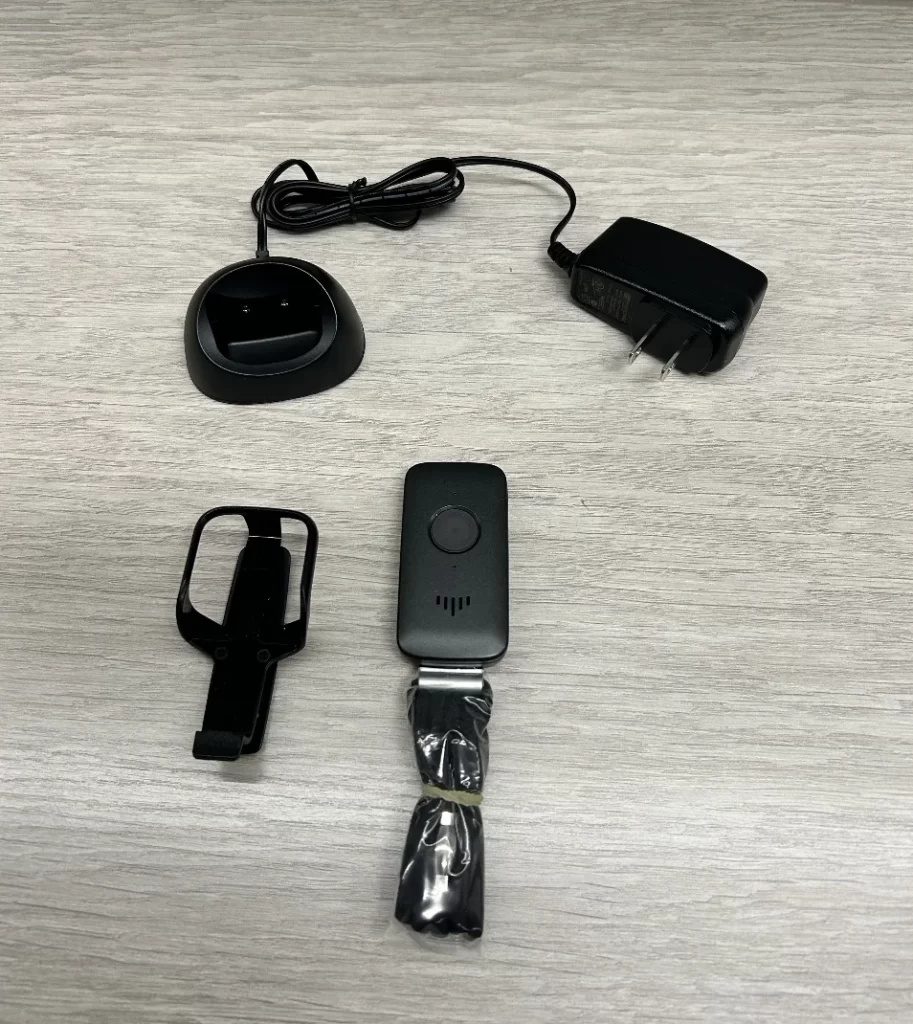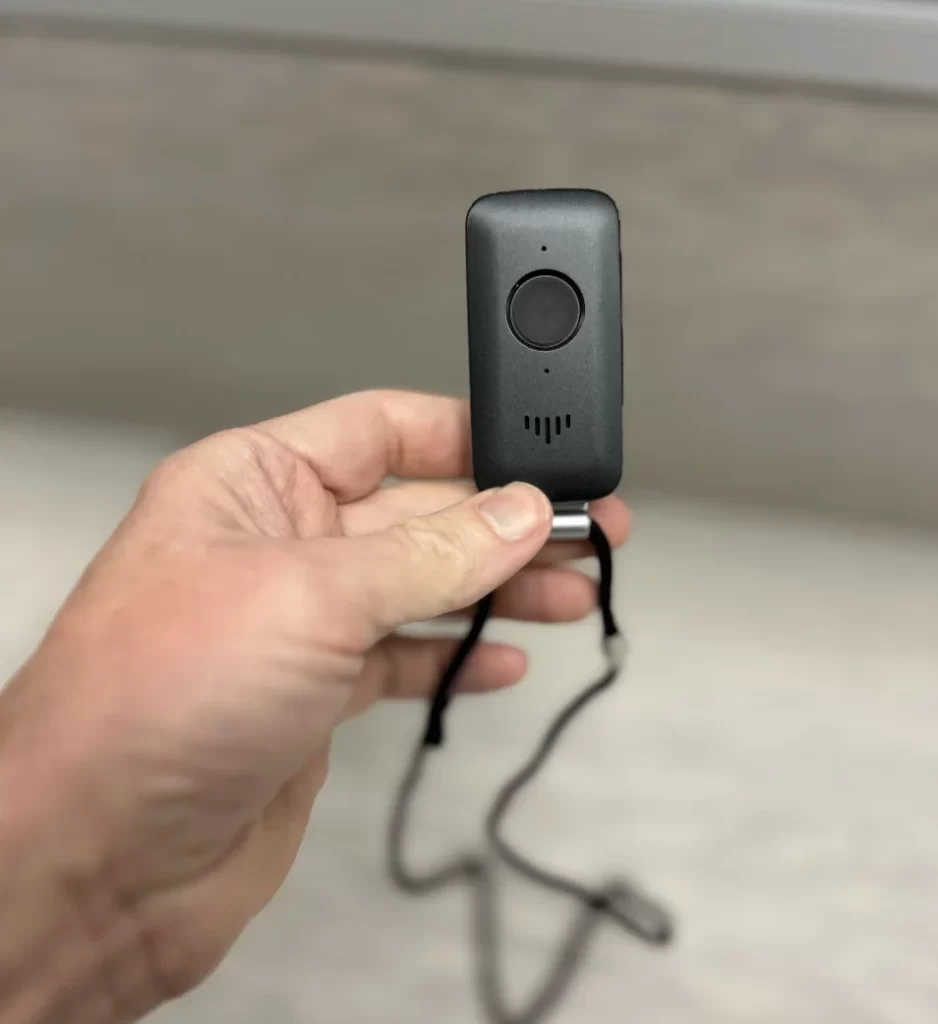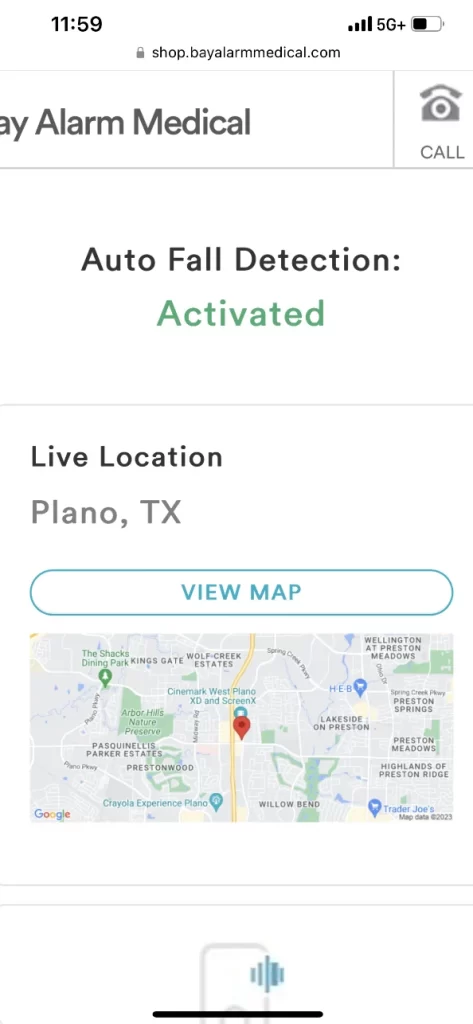MedicalAlertBuyersGuide.org is an independent review site. We may earn compensation from the providers below. Learn More
Bay Alarm Medical SOS Mobile Medical Alert System Review
Updated: March 2024 | ReliaScore™ 8.8 / 10
Product Overview
We have a high opinion of Bay Alarm Medical, naming it as both our top pick for the Best Medical Alert Company and the Best Value Smartwatch. The SOS Mobile medical alert may be our favorite of Bay Alarm Medical’s systems and is our #1 pick for the Best Mobile Medical Alert System.
The SOS Mobile’s elegant design, reliable fall detection, excellent Caregiver Tracking Portal, and overall low cost combine to make it a winner. There are nits we can pick, but these features, combined with the company’s high level of customer service make it a good choice for most seniors and their families.
The SOS Mobile compares favorably to other leading competitors, including:
- Medical Guardian’s MGMini Lite (ReliaScore 8.5/10)
- MobileHelp Micro (ReliaScore 7.5/10)
- Lively Mobile+ (ReliaScore 7.5/10)
- ConnectAmerica Mobile (ReliaScore 7.0/10)
- Lifeline On The Go (ReliaScore 9.0/10 )
It’s worth noting that the SOS Mobile uses identical hardware to the Medical Guardian’s MG Mobile 2.0, though Bay Alarm Medical charges significantly less for its version of the product.
Bay Alarm Medical offers four separate medical alert systems:
- SOS Home – The company’s basic landline-based system.
- SOS Mobile – The system we’re reviewing here.
- SOS Smartwatch – The company’s medical alert smartwatch.
- SOS All-In-One – A bundled system that provides protection “In & Away From Home.”
The SOS Mobile and SOS All-In-One are confusingly similar products. The only real difference between the two is that the SOS All-In-One includes a wearable button that can be worn in a wristband or around the neck.
While our review covers only the SOS Mobile, many of the key points apply to the SOS All-In-One as well.
Key Features
The SOS Mobile is a GPS-enabled medical alert device, which means it can be used away from home. Mobile medical alert systems use a built-in cellular connection to communicate with their emergency monitoring center. The cellular service is included in the monthly subscription. You don’t need an existing cell phone and you don’t need a landline.
With its built-in GPS feature, Bay Alarm Medical’s emergency operators are able to pinpoint the location of the user and direct emergency personnel to the wearer’s location, wherever they are.
The system features a simple, one-button operation. Push and hold the button to generate an emergency alert. The SOS Mobile features two-way communication, which means the emergency operator will answer and speak to you through the device.
The SOS Mobile is one of the few mobile systems to feature a Caregiver Tracking portal, which allows family members or caregivers to monitor the wearer’s location online, as well as check the status of the system and view basic health information.
We find this to be a compelling feature and a major reason why the SOS Mobile is one of our top picks.
The SOS Mobile can be purchased with Fall Detection for $44.95 per month, or without Fall Detection for $34.95 per month. Automatic Fall Detection is one of the main advantages of a mobile medical alert system, since risk for falls increases with age. So, we highly recommend choosing that option.
Automatic fall detection can be problematic though, because of the risk of false alarms. However, the benefits of fall detection easily outweigh the small chance of a false alarm. Devices worn closest to a person’s center of gravity (such as a necklace or pendant) are most accurate.
While Bay Alarm Medical doesn’t require you to sign a long-term contract, you can get discounts if you pre-pay the service on a quarterly or annual plan. With a quarterly plan, you get free shipping. With the Annual plan you get free shipping, plus a free month of monitoring.
If you opt for the Quarterly or Annual plan, know that if you cancel service, you can request a refund for any unused months for which you paid.
Our Testing Experience
Ordering
Bay Alarm Medical’s website was clear and easy to understand. We did have some confusion between the SOS Mobile and the SOS All-In-One system, as noted in our introduction. But otherwise, the purchase process was straightforward.
Bay Alarm Medical’s pricing is transparent. No fees were slipped in during checkout. The final price was exactly as described on the main product page.
The hardware itself cost $69.30. We opted for the SOS Mobile with its Fall Detection option for an additional $10.00 per month. For monthly monitoring, we chose the month-to-month option for $34.95.
Our final price at checkout was $114.25.
Bay Alarm Medical offers excellent service, and that was clear from their post-sales communication. We received an order confirmation email immediately after purchase. Within 24 hours, we received a second email telling us our device had shipped, along with its USPS tracking number.
That email also gave a link to create an online account, along with a welcome packet and instructions on how to fill out an Emergency Plan for the wearer. That plan includes the wearer’s medical history and any medications they have or are currently taking. In case of an emergency, this allows Bay Alarm Medical’s emergency operators to communicate health information to medical personnel.
The equipment itself arrived two days later.
Unboxing & Setup
Setting up the SOS Mobile was relatively easy. The packaging was easy to open, even for a person that might have dexterity issues.

The system arrived already charged and could be set up immediately. You just need to run a test by pressing its emergency button. An automated attendant answers and confirms that you’ve successfully tested the system.
Inside the box we found instructions, the SOS Mobile device itself with a lanyard attached, a charging cradle, and an optional belt clip.

We really liked the look and feel of the SOS Mobile. The system is about the size of a car key fob and feels comfortable in your hand.

Most of the time spent during setup involves deciding how you’ll wear the device. See our video on this.
The system comes with a lanyard attached so you can wear it around your neck, if that’s what you prefer.
A belt clip is also included, in case you prefer to wear the alert on your hip.
However, you’ll need to decide whether you prefer to use the belt clip or the lanyard because with the lanyard attached, the system does not fit well into the belt clip. The lanyard is easy to remove (see our video): you just grab its silver base and twist it. With the lanyard removed, the alert fits snuggly into the belt clip.
When we first used the belt clip, we struggled a bit to slip the device out of the holder. You need to remove the clip each time you want to charge the device, so this is a potential problem. We have full use and strength of our hands, but still struggled to detach the device. That said, after a few hours of use, the clip softened up and we could easily snap the device in and out. If you have the same experience, don’t give up on the belt clip right away.
Testing the System
We tested the SOS Mobile in a real world usage case, triggering alerts while running errands around town. A common reason that families buy mobile systems is that they offer peace of mind for persons with dementia and their loved ones. Alzheimer’s and other forms of dementia cause people to get lost in familiar surroundings. Six out of every ten people with dementia will wander at least once, and many will do so repeatedly. Wandering, while common, can be dangerous — even fatal — and the stress of this risk weighs heavily on caregivers and family.
The SOS Mobile is a GPS medical alert, which means it should be able to determine your location anywhere you go. We were able to use the SOS Mobile’s Caregiver Tracking feature to check our location as we moved around town and confirmed that our location was accurate (read more about this under Caregiver Tracking below).
We tested the device itself in Plano, Texas, about a 20-minute drive from our home. In this test, Bay Alarm Medical’s call center was a bit slow to respond, taking a full 3 minutes to speak to us through the device. However, at exactly the same time our cell phone rang with a call from the Plano Fire & Rescue Department, asking if we needed help. That means that the operator communicated with the EMTs, calling the fire department closest to our location.
Indeed, we were able to log into the Caregiver Tracking Portal on our iPhone to confirm our current location. The portal accurately showed our location within about 100 feet of our true position.
On the whole, this test gave impressive positive results.
GPS Tracking & Online Caregiver Portal
The SOS Mobile is one of the few mobile medical alerts to feature an online Caregiver Tracking portal. The portal allows you to see the wearer’s location in real time.
In our opinion, Caregiver Tracking is a key feature if you’re buying the medical alert system for a loved one, especially if they suffer from memory issues such as Alzheimer’s or dementia. In addition to contacting medical personnel for emergencies, medical alert systems can be used to call for help if your loved one gets locked out of their home, experiences a power outage, or observes suspicious or threatening activity.
The Caregiver Tracking portal is included on the account management page when you log into BayAlarmMedical.com. The portal shows a map with the wearer’s current location. Tap on the map to see a larger map with the wearer’s exact coordinates, shown in latitude/longitude.

The Caregiver Tracking Portal showing our current location
Though you might wish the portal displayed the wearer’s street address, instead of their latitude/longitude coordinates, keep in mind that these coordinates can pinpoint a location in places without a street address, such as a park or on a walking trail, so it’s more useful than a simple street address. You can tap “View larger map” to open Google Maps / Apple Maps and get driving directions to these coordinates too.
It’s important for the system’s built-in GPS to give an accurate location for the wearer. In our tests, the GPS pinpointed our location to within an average of 113 feet. That’s pretty good.
Note that the SOS Mobile and the SOS All-In-One systems are the only Bay Alarm Medical products that feature the Caregiver Tracking portal. It’s not available for the company’s SOS Home or SOS Smartwatch systems.
Fall Detection
Automatic fall detection is a key feature of the SOS Mobile. Having tested multiple medical alert systems, we think Bay Alarm Medical’s implementation of fall detection is one of the best on the market.
When automatic fall detection is triggered, the system will announce “Fall detected! Hold the Call button to cancel.” You can then hold the Call button until the system announces “Fall detection canceled,” or wait for an emergency operator to come on the line. You have about 15 seconds to do this, which should be enough time to cancel a false alarm.
The system itself is quite sensitive: dropping the device onto a tabletop from a 1-foot height will trigger an alert. Likewise, dropping it onto a car seat from shoulder height will trigger an alert.
At the same time, the system can set off false alarms if not worn as recommended. During one of our tests we kept the device in our pants pocket, which is not as directed. Running errands around town, we accidentally bumped our leg with a shopping bag and set off the device (we were able to quickly cancel the alert by holding the Call button).
Bay Alarm Medical tells you to wear the SOS Mobile either around your neck, but outside your clothes, or on your hip using the belt clip.
We tried other tests to see if we could deliberately set off a false alarm.
With the lanyard attached, we swung the device and bumped it into our hand. This didn’t trigger an alert. That means you can comfortably wear the device around your neck without fear that it will set off an alert bumping against your chest.
We also held the device in our hand while exercising. Even while performing jumping jacks, we couldn’t trigger a false alarm. That’s also good.
Despite the small chance of a false alarm, we find automatic fall detection to be a compelling feature in a medical alert system.
The risk is small and you can easily cancel a false alarm if it occurs. The benefits of fall detection easily outweigh the risks.
Battery Life
The SOS Mobile has a long battery life, far longer than the SOS Smartwatch and other medical alert watches. Keep that in mind if you’re trying to decide between a mobile medical alert and a smartwatch medical alert.
Just how long does the SOS Mobile’s battery last? Bay Alarm Medical says their system can last up to 6 days on a single charge. In our case the system sat in its box for three weeks before we had a chance to test it, at which point we saw that it still had a 55% charge. Even during active use, the system lost only 20% charge over four days of testing.
Like other mobile medical alerts and smartwatches, the SOS Mobile comes with a convenient charging cradle. When you set the unit into the cradle, pins on the back of the device match up with charging pins on the cradle. The alert’s button will then start blinking, indicating that it is charging, and a voice will also announce that it is charging. This helps you know that you’ve properly seated the device.
If you choose to wear the SOS Mobile using its belt clip, you’ll need to slip the device out of the clip before charging.
Not to pick nits, but one minor negative is that the emergency button will periodically blink red while charging. If you place the system on your nightstand at bedtime, that could be annoying in a dark bedroom.
Pricing
When comparing medical alert systems, it’s important to look at the one-year cost of ownership, and not just the initial purchase price of the system. Some companies have relatively affordable initial prices, but feature expensive monthly monitoring. That means the full year cost of ownership can be significantly higher.
Bay Alarm Medical features lower monthly monitoring costs than many of the other systems we reviewed. That’s a plus.
The SOS Mobile falls in the middle of the mobile medical alert systems we reviewed. It’s 1-year cost of ownership is $211.60 less than MedicalAlert.com, $213.15 cheaper than Medical Guardian’s MGMini Life and fully $300.60 less than Lifeline On The Go.
| Company | System | Startup Cost | Monitoring | Fall Detection | First Year Total Cost |
|---|---|---|---|---|---|
| Bay Alarm Medical | SOS Mobile | $69.30 | $34.95/month | $10.00/month | $620.70 |
| MedicalAlert.com | Mobile | $124.90 | $47.95/month | $10.00/month | $820.30 |
| Lifeline | On The Go | $129.90 | $49.95/month | $15.00/month | $909.30 |
2 - First Year Total Cost assumes a monthly subscription plan with fall detection.
With this affordable option, it’s worth asking whether Bay Alarm Medical’s monitoring is of comparable quality. Our experience says “yes.” Bay Alarm Medical’s monitoring center is based in the United States and carries a 4-Diamond certification.
Returns & Refunds
Sometimes a medical alert system doesn’t work for you (or you can’t persuade your loved one to wear it…). That’s why it’s good to understand each company’s returns policy and know that you can trust them to stand behind it.
Bay Alarm Medical allows you to cancel your monthly monitoring service at any time. If you’ve pre-paid under a Quarterly or Annual plan, your unused months will be refunded.
If you cancel within 30 days of purchase, you can also return your hardware for a full refund. We did exactly that, returning our system 23 days after purchase.
The return process was easy. We phoned the company and requested cancellation. They honored our return with no questions asked.
Within 24 hours we received an email with instructions on how to return the equipment. That included important instructions on how to power off the equipment. Pay attention to those instructions, otherwise you risk triggering an alert when UPS handles your package!
We boxed the system and returned it via UPS. We did have to pay for the return shipping.
Bay Alarm Medical promised a refund within 3 weeks of receipt. In our case we received our equipment refund of $138.95 within 14 days of returning the equipment. That included an email confirming our refund, which was nice.
Overall, the company had the smoothest returns process among the vendors we tested.
The Bottom Line
The combination of a fair price, good service, reliable GPS geolocation, reliable fall detection, and a good Caregiver Tracking portal combine to make the SOS Mobile our choice for the Best Mobile Medical Alert System.
Overall the SOS Mobile was one of the best medical alert systems of any type we tested. While we had some minor issues initially with the system’s belt clip and lanyard, it’s picking nits to mention these.
| Pros: | Cons: |
|
|

 1-855-412-1539
1-855-412-1539
One Reply to “Bay Alarm Medical SOS Mobile Medical Alert System Review”